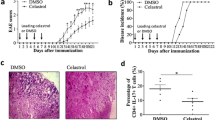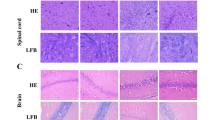Abstract
Experimental autoimmune encephalomyelitis (EAE) is a classical experimental model of multiple sclerosis (MS), an autoimmune disease of the central nervous system (CNS). Previous reports have suggested that matrine (MAT), a quinolizidine alkaloid derived from the herb Radix Sophorae Flave, could inhibit clinical EAE, but its mechanism of action is not clear. Our present study showed that MAT treatment resulted in dose-dependent reduction in neurological scores. Consistent with this observation, infiltration of inflammatory cells and demyelination in the CNS were also significantly suppressed. We further studied the mechanism underlying these effects of MAT by determining whether this treatment influences expression of molecules that are involved in the activation and migration of inflammatory cells. Our results showed that MAT significantly inhibited expression and production in the CNS of ICAM-1 and VCAM-1, key adhesive molecules, and CCL3 and CCL5, key chemokines, that attract inflammatory cells into the CNS. Furthermore, the TLR4/MD2 pathway, which plays an important role in the induction of Th1/Th17 cells in EAE, was also significantly inhibited. Together, our study not only demonstrates that MAT may be a novel therapeutic option for the treatment for MS, but also provides further information on mechanisms underlying the effect of MAT treatment.





Similar content being viewed by others
Change history
08 October 2022
A Correction to this paper has been published: https://doi.org/10.1007/s12026-022-09327-3
References
Popescu BF, Lucchinetti CF. Pathology of demyelinating diseases. Annu Rev Pathol. 2012;7:185–217. doi:10.1146/annurev-pathol-011811-132443.
Kawakami N, Bartholomaus I, Pesic M, Mues M. An autoimmunity odyssey: how autoreactive T cells infiltrate into the CNS. Immunol Rev. 2012;248(1):140–55. doi:10.1111/j.1600-065X.2012.01133.x.
Saidha S, Eckstein C, Calabresi PA. New and emerging disease modifying therapies for multiple sclerosis. Ann N Y Acad Sci. 2012;1247:117–37. doi:10.1111/j.1749-6632.2011.06272.x.
Dore-Duffy P, Washington R, Dragovic L. Expression of endothelial cell activation antigens in microvessels from patients with multiple sclerosis. Adv Exp Med Biol. 1993;331:243–8.
Holman DW, Klein RS, Ransohoff RM. The blood-brain barrier, chemokines and multiple sclerosis. Biochim Biophys Acta. 2011;1812(2):220–30. doi:10.1016/j.bbadis.2010.07.019.
Segal BM. CNS chemokines, cytokines, and dendritic cells in autoimmune demyelination. J Neurol Sci. 2005;228(2):210–4. doi:10.1016/j.jns.2004.10.014.
Sorensen TL, Tani M, Jensen J, Pierce V, Lucchinetti C, Folcik VA, et al. Expression of specific chemokines and chemokine receptors in the central nervous system of multiple sclerosis patients. J Clin Invest. 1999;103(6):807–15. doi:10.1172/JCI5150.
Yang J, Yan Y, Ma CG, Kang T, Zhang N, Gran B, et al. Accelerated and enhanced effect of CCR5-transduced bone marrow neural stem cells on autoimmune encephalomyelitis. Acta Neuropathol. 2012;124(4):491–503. doi:10.1007/s00401-012-0989-1.
Bromley SK, Mempel TR, Luster AD. Orchestrating the orchestrators: chemokines in control of T cell traffic. Nat Immunol. 2008;9(9):970–80. doi:10.1038/ni.f.213.
Zhang GX, Baker CM, Kolson DL, Rostami AM. Chemokines and chemokine receptors in the pathogenesis of multiple sclerosis. Mult Scler. 2000;6(1):3–13.
Hla T, Oo ML. Ramping up RANTES in the acute response to arterial injury. J Clin Invest. 2010;120(1):90–2. doi:10.1172/JCI41738.
Christiansen D, Brekke OL, Stenvik J, Lambris JD, Espevik T, Mollnes TE. Differential effect of inhibiting MD-2 and CD14 on LPS- versus whole E. coli bacteria-induced cytokine responses in human blood. Adv Exp Med Biol. 2012;946:237–51. doi:10.1007/978-1-4614-0106-3_14.
Reynolds JM, Martinez GJ, Chung Y, Dong C. Toll-like receptor 4 signaling in T cells promotes autoimmune inflammation. Proc Natl Acad Sci USA. 2012;109(32):13064–9. doi:10.1073/pnas.1120585109.
Li T, Wong VK, Yi XQ, Wong YF, Zhou H, Liu L. Matrine induces cell anergy in human Jurkat T cells through modulation of mitogen-activated protein kinases and nuclear factor of activated T-cells signaling with concomitant up-regulation of anergy-associated genes expression. Biol Pharm Bull. 2010;33(1):40–6.
Zhang Y, Wang S, Li Y, Xiao Z, Hu Z, Zhang J. Sophocarpine and matrine inhibit the production of TNF-alpha and IL-6 in murine macrophages and prevent cachexia-related symptoms induced by colon26 adenocarcinoma in mice. Int Immunopharmacol. 2008;8(13–14):1767–72. doi:10.1016/j.intimp.2008.08.008.
Zhou Y, Wang H, Liang L, Zhao WC, Chen Y, Deng HZ. Total alkaloids of Sophora alopecuroides increases the expression of CD4+ CD25+ Tregs and IL-10 in rats with experimental colitis. Am J Chin Med. 2010;38(2):265–77.
Zhao X, Kan Q, Zhu L, Zhang GX. Matrine suppresses production of IL-23/IL-17 and ameliorates experimental autoimmune encephalomyelitis. Am J Chin Med. 2011;39(5):933–41. doi:10.1142/S0192415X11009317.
Ozugurlu F, Sahin S, Idiz N, Akyol O, Ilhan A, Yigitoglu R, et al. The effect of Nigella sativa oil against experimental allergic encephalomyelitis via nitric oxide and other oxidative stress parameters. Cell Mol Biol (Noisy-le-grand). 2005;51(3):337–42.
Merkler D, Ernsting T, Kerschensteiner M, Bruck W, Stadelmann C. A new focal EAE model of cortical demyelination: multiple sclerosis-like lesions with rapid resolution of inflammation and extensive remyelination. Brain. 2006;129(Pt 8):1972–83. doi:10.1093/brain/awl135.
Bullard DC, Hu X, Schoeb TR, Collins RG, Beaudet AL, Barnum SR. Intercellular adhesion molecule-1 expression is required on multiple cell types for the development of experimental autoimmune encephalomyelitis. J Immunol. 2007;178(2):851–7.
Engelhardt B. Molecular mechanisms involved in T cell migration across the blood-brain barrier. J Neural Transm. 2006;113(4):477–85. doi:10.1007/s00702-005-0409-y.
Sharief MK, Noori MA, Ciardi M, Cirelli A, Thompson EJ. Increased levels of circulating ICAM-1 in serum and cerebrospinal fluid of patients with active multiple sclerosis. Correlation with TNF-alpha and blood-brain barrier damage. J Neuroimmunol. 1993;43(1–2):15–21.
Rieckmann P, Nunke K, Burchhardt M, Albrecht M, Wiltfang J, Ulrich M, et al. Soluble intercellular adhesion molecule-1 in cerebrospinal fluid: an indicator for the inflammatory impairment of the blood-cerebrospinal fluid barrier. J Neuroimmunol. 1993;47(2):133–40.
Huang D, Han Y, Rani MR, Glabinski A, Trebst C, Sorensen T, et al. Chemokines and chemokine receptors in inflammation of the nervous system: manifold roles and exquisite regulation. Immunol Rev. 2000;177:52–67.
Karpus WJ, Kennedy KJ. MIP-1alpha and MCP-1 differentially regulate acute and relapsing autoimmune encephalomyelitis as well as Th1/Th2 lymphocyte differentiation. J Leukoc Biol. 1997;62(5):681–7.
Liu L, Huang D, Matsui M, He TT, Hu T, Demartino J, et al. Severe disease, unaltered leukocyte migration, and reduced IFN-gamma production in CXCR3−/− mice with experimental autoimmune encephalomyelitis. J Immunol. 2006;176(7):4399–409.
Mellanby RJ, Cambrook H, Turner DG, O'Connor RA, Leech MD, Kurschus FC, et al. TLR-4 ligation of dendritic cells is sufficient to drive pathogenic T cell function in experimental autoimmune encephalomyelitis. J Neuroinflamm. 2012;9:248. doi:10.1186/1742-2094-9-248.
Hou SW, Liu CY, Li YH, Yu JZ, Feng L, Liu YT, et al. Fasudil ameliorates disease progression in experimental autoimmune encephalomyelitis, acting possibly through antiinflammatory effect. CNS Neurosci Ther. 2012;18(11):909–17. doi:10.1111/cns.12002.
Tang H, Pang S, Wang M, Xiao X, Rong Y, Wang H, et al. TLR4 activation is required for IL-17-induced multiple tissue inflammation and wasting in mice. J Immunol. 2010;185(4):2563–9. doi:10.4049/jimmunol.0903664.
Mao YM, Zeng MD, Lu LG, Wan MB, Li CZ, Chen CW, et al. Capsule oxymatrine in treatment of hepatic fibrosis due to chronic viral hepatitis: a randomized, double blind, placebo-controlled, multicenter clinical study. World J Gastroenterol. 2004;10(22):3269–73.
Acknowledgments
This study was supported by grants from the Experimental Animal Center of Henan, China. We thank Katherine Regan for editorial assistance and Zichen Li for technical help.
Author information
Authors and Affiliations
Corresponding authors
Rights and permissions
About this article
Cite this article
Kan, QC., Zhu, L., Liu, N. et al. Matrine suppresses expression of adhesion molecules and chemokines as a mechanism underlying its therapeutic effect in CNS autoimmunity. Immunol Res 56, 189–196 (2013). https://doi.org/10.1007/s12026-013-8393-z
Published:
Issue Date:
DOI: https://doi.org/10.1007/s12026-013-8393-z




